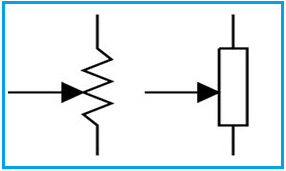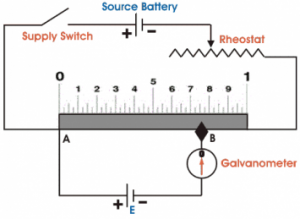Potentiometer
The potentiometer is an electric instrument that used to measure to Electro Motive Force of a given cell, the internal resistance of a cell and also it is used to compare MFs of different cells. It can also use as a resistor in most of the applications. These potentiometers are used in huge quantities in the manufacture of electronics equipment that provides a way of adjusting electronic circuits so that the correct outputs are obtained. Although their most obvious use must be for volume controls on radios and other electronic equipment used for audio.
Why is Potentiometer chosen over Voltmeter to measure the potential (EMF) of a cell?
When we use Voltmeter, current flows through the circuit and because of the internal resistance of the cell, always terminal potential will be less than the actual cell potential. In this circuit, when the potential difference is balanced (using a Galvanometer null detection), no current flows in the circuit, so the terminal potential will be equal to the actual cell potential. So we can understand that the Voltmeter measures the terminal potential of a cell, but this measures actual cell potential. The schematic symbols of this is shown below.

Working Principle of Potentiometer: This is a very basic instrument used for comparing emf two cells and for calibrating ammeter, voltmeter and watt-meter. The basic working principle of potentiometer is very simple. Suppose we have connected two battery in head to head and tale to tale through a galvanometer. That means the positive terminals of both battery are connected together and negative terminals are also connected together through a galvanometer as shown in the figure below.

Here in the figure it is clear that if the voltage of both battery cells is exactly equal, there will be no circulating current in the circuit and hence the galvanometer shows null deflection. The working principle of potentiometer depends upon this phenomenon. Now, where a battery is connected across a resistor via a switch and a rheostat as shown in the figure below, there will be a voltage drop across the resistor. As there is a voltage drop across the resistor, this portion of the circuit can be considered as a voltage source for other external circuits. That means anything connected across the resistor will get voltage. If the resistor has uniform cross section throughout its length, the electrical resistance per unit length of the resistor is also uniform throughout its length.
Hence, voltage drop per unit length of the resistor is also uniform. Suppose the current through the resistor is i A and resistance per unit length of the resistor is r Ω. Then the voltage appears per unit length across the resistor would be and say it is v volt. Now, positive terminal of a standard cell is connected to point A on the sliding resistor and negative terminal of the same is connected with a galvanometer. Other end of the galvanometer is in contact with the resistor via a sliding contact as shown in the figure above. By adjusting this sliding end, a point like B is found where, there is no current through the galvanometer, hence no deflection of galvanometer.
That means emf of the standard cell is just balanced by the voltage drop appears across AB. Now if the distance between point A and B is L, then it can be written emf of standard cell. As v (voltage drop per unit length of the sliding resistor) is known and L is measured from the scale attached to the resistor, the value of E i.e. emf of standard cell.

How a DC potentiometer can compare emf’s of two different cells?
The positive terminals of the cells and source battery are joined together. The negative terminals of the cells are joined with the galvanometer in turn through a two-way switch. The other end of the galvanometer is connected to a sliding contact on the resistor. Now by adjusting sliding contact on the resistor, it is found that the null deflection of galvanometer comes for first cell at a length of L on the scale and after positioning to way switch to second cell and then by adjusting the sliding contact, it is found that the null deflection of galvanometer comes for that cell at a length of L₁ on the scale. Let’s think of the first cell as standard cell and its emf is E and second cell is unknown cell whose emf is E₁.
Now as per above explanation, E = Lv volt and L₁ = L₁v volt.
Dividing one equation by other, we get:
As the emf of the standard cell is known, hence emf of the unknown cell can easily be determined.

